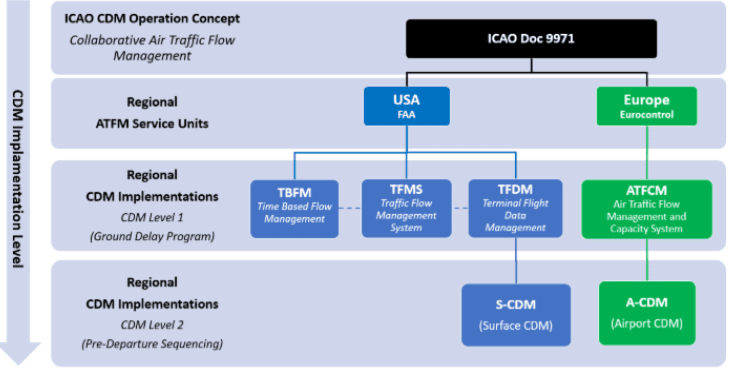Prior to even start in the conceptual definition of CDM Operation, it is essential to deconstruct a myth which has been wrongly disseminated in the less Air Traffic Management knowledgeable regions.
CDM Operation was NOT conceived to increase Air Transport Service capacity, but rather to enforce demand x capacity balance, in high-demand operational scenarios, through introduction of gradual interferences in aircraft operators´ flight intentions.
Perfect understanding of the above, especially by airlines, is of fundamental relevance, for a realistic assessment of the adoption of any CDM Operation-based initiative, under the risk of facing unexpected operational restrictions, where "collaboration and information sharing" were erroneously perceived as CDM Operation´s only requirements.
Any and all Air Transport Service planners, providers and regulators should be knowledgeable on ICAO Doc. 9971 (Manual on Collaborative Air Traffic Flow Management), which settled the basis of CDM Operation concept.
With special emphasis, the following aspects associated with CDM Operation concept should be perfectly comprehended prior to any attempts to adopt its derived initiatives.
CDM Operation is a network operation philosophy, proposed by ICAO, for Demand x Capacity balance, after all efforts for capacity increase (on the ground and in airspace) have been exhausted, as it enforces interferences to aircraft operators´ flight intentions.
Attempting to adopt CDM Based initiatives for capacity increase means limiting demand to balance underutilized capacity.
Highly predictable damaging consequences of it, have been experienced by careless attempts to adopt Eurocontrol A-CDM airport operational concept, at airports where initiatives such as Apron Management Service and use of Surface Surveillance technologies had never been taken.
CDM Operation is only applicable at cultural environments where Air Transport Service´s fuel efficiency, environmental protection and flight time regularity be assigned higher priority than door-close and takeoff punctuality. Any deviations from this rule will lead to operational chaos and frustrated expectations, given that CDM Operation enforces gradual delays to pushback and takeoff maneuvers, as needed to balance demand vs capacity.
CDM Operation proposes two gradual levels of interference with aircraft operators´ flight intentions:
- Ground Delay Program, which imposes small tactical delays (CTOTs) to flights beyond airspace predicted capacity, with the aim of mitigating enroute congestions.
- Pre-Departure Sequencing, which imposes potential delays (TSAT - TOBT) and flexibility restriction (TSAT +/- 5min) to all flights, with the aim of mitigating surface congestions.
Both Ground Delay Program and Pre-Departure Sequencing require high level of surface operation´s predictability, as they rely on Aircraft Operators´ extremely accurate Estimates (Targets).
Once more, that explains why attempting to adopt CDM Operation-based concepts, prior to improving surface operations´ predictability - Apron Management Service and use of Surface Surveillance technologies ? is the shortest path to chaos, by trying to perform complex and precise calculations, making use of poorly accurate numbers.
United States and Europe have built long and different roadmaps, towards CDM Operation, led by their Air Traffic Flow Management service units (FAA and Eurocontrol), starting with Ground Delay Program and further evolving to Pre-Departure Sequencing (Metering).
Illustration below offers a high-level view of the FAA´s and Eurocontrol´s CDM Operation roadmaps.

For those interested in the FAA´s and Eurocontrol´s regional CDM Operation-based initiatives, the following links provide interesting educational experiences:
FAA (United States)
- TBFM: https://storyboard.faa.gov/detailedwebpages/tbfm.html
- TFMS: https://storyboard.faa.gov/detailedwebpages/tfms.html
- TFDM: https://storyboard.faa.gov/detailedwebpages/tfdm.html
- S-CDM: https://cdm.fly.faa.gov/?page_id=221
Eurocontrol
- ATFCM: https://www.eurocontrol.int/publication/atfcm-users-manual
- A-CDM: https://www.eurocontrol.int/publication/airport-collaborative-decision-making-cdm-implementation-manual
ATMWISE is technically prepared and committed to assist Air Transport Service planners, providers and regulators, at any region, to assess the conceptual elements adopted by the FAA and Eurocontrol, in their CDM Operation roadmaps, with a view to conceive, design and implement regional CDM Operation initiatives, fully aligned with each region´s political, administrative, operational and cultural environment.
When you see one airport, you have seen only one airport. When you see a region, you have seen only one region!
CDM Operation has to be thought of as a regional program!

